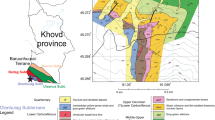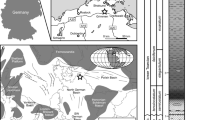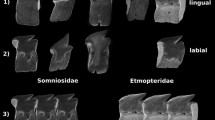Abstract
A new Jurassic species of the very rare and incompletely known synechodontiform shark, Welcommia, is described. The new species, Welcommia cappettai, is represented only by a single tooth, precluding reconstruction of its dentition in detail. Nevertheless, this specimen provides sufficient information and characteristics to establish its taxonomic status. Welcommia cappettai n. sp. occurs in the middle Oxfordian (Upper Jurassic) of south-western Germany. This is the first unambiguous record and named species of Welcommia from the Late Jurassic, substantially reducing the rather large gap in the fossil record of this synechodontiform taxon. So far, two Welcommia species from the Lower Jurassic of Belgium and the Lower Cretaceous of southern France have been described. An additional, still unnamed species seemingly occurs in the Oxfordian of southern France. The new species has plesiomorphic and apomorphic characteristics and, probably, an intermediate dental pattern that tentatively enables reconstruction of evolutionary trends in the dentition of this shark from small and compact teeth with broad, almost triangular cusps, to mesio-distally lengthened teeth with elongated mesial heels resulting in an extremely extended mesial cutting edge in addition to more delicate cusp and cusplets in advanced forms. These differences might be related to improved feeding mechanisms. It is hypothesized that Welcommia was predominantly a component of the Mediterranean faunal province. The disappearance of Welcommia in the Early Cretaceous remains ambiguous and might be related to competition by other sharks, for example hexanchiforms, or might represent a collecting bias and/or taxonomic misidentification of isolated teeth.
Kurzfassung
Eine neue jurassische Art des sehr seltenen und kaum bekannten synechodontiformen Haies Welcommia wird beschrieben. Die neue Art, Welcommia cappettai, ist leider nur durch einen einzigen latero-anterioren Zahn belegt, der somit eine Rekonstruktion des Gebisses unmöglich macht. Jedoch besitzt der Zahn eine einzigartige Merkmalskombination, die die Errichtung einer neuen Art rechtfertigt. W. cappettai n. sp. kommt im mittleren Oxford (Oberjura) Südwestdeutschlands vor und ist der bisher einzig zweifelsfreie Nachweis und die erste benannte Art von Welcommia aus dem Oberjura. Diese Art reduziert die relativ große Lücke in der Fossilüberlieferung dieses Taxons. Bisher sind zwei Arten von Welcommia aus dem belgischen Unterjura und der Unterkreide Südfrankreichs beschrieben worden. Eine weitere, bisher noch unbenannte Art kommt im südfranzösischen Oxford vor. Welcommia scheint im Oberjura ein typisches Element der Mediterranen Faunenprovinz gewesen zu sein. Die Merkmalskombination deutet auf ein intermediäres dentales Muster zwischen den unterjurassischen und unterkretazischen Formen hin und weist auf evolutive Trends im Gebiss von kompakten Zähnen mit breitem, meist triangularen Spitzen, über mesio-distal lang gezogene Zähne mit verlängerten mesialen Ausläufern, bis hin zu extrem ausgedehnten mesialen Schneidekanten in Kombination mit delikateren Haupt- und Nebenspitzen in den abgeleiteten Formen. Diese Unterschiede stehen möglicherweise in Verbindung mit Ernährungsanpassungen. Das Verschwinden von Welcommia in der Unterkreide bleibt ungeklärt und steht eventuell entweder in Zusammenhang mit Konkurrenz zu anderen Haien (z.B. Hexanchiformen) oder ist ein Sammlungsartefakt bzw. Fehlbestimmung von isolierten Zähnen.



Similar content being viewed by others
References
Agassiz, J.L.R. 1833–1844. Recherches sur les poissons fossiles. Imprimerie de Petitpierre, Neuchâtel, 1420 pp in 5 vol., with supplements.
Bonaparte, C.L.J.L. 1838. Selachorum tabula analytica. Nuovi Annali delle Scienze Naturali 2: 195–214.
Cappetta, H. 1990. Hexanchiforme nouveau (Neoselachii) du Crétacé inférieur du sud de la France. Palaeovertebrata 20: 33–54.
Cione, A.L., and F. Medina. 2009. The oldest hexanchiform shark from the Southern Hemisphere (Neoselachii; Early Cretaceous, Antarctica). Antarctic Science 21: 501–504.
Compagno, L.J.V. 1977. Phyletic relationships of living sharks and rays. American Zoologist 17: 303–322.
Cuny, G., and S. Risnes. 2005. The enameloid microstructure of the teeth of synechodontiform sharks (Chondrichthyes: Neoselachii). PalArch’s Journal of Vertebrate Palaeontology 3: 1–12.
Cuny, G., O. Rieppel, and P.M. Sander. 2001. The shark fauna from the Middle Triassic (Anisian) of North-Western Nevada. Zoological Journal of the Linnean Society 133: 285–301.
Delsate, D., and P. Godefroit. 1995. Chondrichthyens du Toarcien inférieur d’Aubange (Lorraine belge). Professional Paper of the Geological Survey of Belgium 278: 23–43.
Duffin, C.J., and D.J. Ward. 1993. The Early Jurassic Palaeospinacid sharks of Lyme Regis, southern England. Professional Paper of the Geological Survey of Belgium 264: 53–102.
Hay, O.P. 1902. Bibliography and catalogue of fossil vertebrata of North America. Bulletin of the United States Geological Survey 179: 1–868.
Huxley, T.H. 1880. On the application of the laws of evolution to the arrangement of the Vertebrata and more particularly of the Mammalia. Proceedings of the Zoological Society of London 1880: 649–662.
Ivanov, A. 2005. Early Permian chondrichthyans of the Middle and South Urals. Revista Brasileira de Paleontologia 8: 127–138.
Klug, S. 2008. The Late Jurassic neoselachian Macrourogaleus Fowler, 1947 is a plaeospinacid shark (Elasmobranchii; Synechodontiformes). Acta Geologica Polonica 58: 229–234.
Klug, S. 2009. A new palaeospinacid shark (Chondrichthyes, Neoselachii) from the Upper Jurassic of southern Germany. Journal of Vertebrate Paleontology 29(2): 326–335.
Klug, S. 2010. Monophyly, Phylogeny and Systematic Position of the Synechodontiformes (Chondrichthyes, Neoselachii). Zoologica Scripta 39: 37–49.
Klug, S., and J. Kriwet. 2008. A new basal galeomorph shark (Synechodontiformes, Neoselachii) from the Early Jurassic of Europe. Naturwissenschaften 95(5): 443–448.
Klug, S., J. Kriwet, R. Böttcher, G. Schweigert, and G. Dietl. 2009. Skeletal anatomy of the extinct shark Paraorthacodus jurensis (Chondrichthyes; Palaeospinacidae), with comments on synechodontiform and palaeospinacid monophyly. Zoological Journal of the Linnean Society 157: 107–134.
Kriwet, J. 2003. Neoselachian remains (Chondrichthyes, Elasmobranchii) from the Middle Jurassic of SW Germany and NW Poland. Acta Palaeontologica Polonica 48(4): 587–598.
Pienkowski, G., M.E. Schudack, P. Bosák, R. Enay, A. Feldman-Olszewska, J. Golonka, J. Gutowski, G.F.W. Herngreen, P. Jordan, M. Krobicki, B. Lathuiliere, R.R. Leinfelder, J. Michalík, E. Mönnig, N. Noe-Nygaard, J. Pálfy, A. Pint, M.W. Rasser, A.G. Reisdorf, D.U. Schmid, G. Schweigert, F. Surlyk, A. Wetzel, and T.E. Wong. 2008. Jurassic. In The geology of Central Europe, Volume 2–Mesozoic and Cenozoic, ed. T. McCann, 823–922. USA: The Geological Society of America.
Rees, J. 2000. A new Pliensbachian (Early Jurassic) neoselachian shark fauna from southern Sweden. Acta Palaeontologica Polonica 45: 407–424.
Schweigert, G. 2000. Immigration of Amoeboceratids into the Submediterranean Upper Jurassic of SW Germany. In Advances in Jurassic Research 2000, ed. Hall, R. L., and P. Smith, vol. 6, pp. 203–210. GeoResearch Forum.
Thies, D. 1992. A new species of Palaeospinax (Chondrichthyes, Neoselachii) from the Lower Jurassic Posidonia Shale of Southern Germany. Paläontologische Zeitschrift 66: 137–146.
Underwood, C.J., and D.J. Ward. 2004. Neoselachian sharks and rays from the British Bathonian (Middle Jurassic). Palaeontology 47: 447–501.
Ward, D.J., and D. Thies. 1987. Hexanchid shark teeth (Neoselachii, Vertebrata) from the Lower Cretaceous of Germany and England. Mesozoic Research 1: 89–106.
Acknowledgments
We are grateful to P. Forey, A. Longbottom and Z. Johansson (Natural History Museum, London), R. Böttcher (Staatliches Museum für Naturkunde, Stuttgart, SMNS), and E. Steurbaut and A. Folie (Royal Belgian Institute of Natural Sciences, Brussels; RBINS) for making material under their care available for this study. We are indepted to A. Lehmkuhl (SMNS) for collecting the specimens described herein. G. Schweigert (SMNS) is acknowledged for information on ammonite faunas and palaeogeographic patterns during the Late Jurassic and the stratigraphic age of the fossil-bearing strata at Blumberg. Two anonymous reviewers are acknowledged for their helpful comments. This study was supported by grants of the RBINS to SK and of the German Research Foundation (DFG, KR 2307/3-2) to JK.
Author information
Authors and Affiliations
Corresponding author
Rights and permissions
About this article
Cite this article
Klug, S., Kriwet, J. A new Late Jurassic species of the rare synechodontiform shark, Welcommia (Chondrichthyes, Neoselachii). Paläontol Z 84, 413–419 (2010). https://doi.org/10.1007/s12542-010-0058-9
Received:
Accepted:
Published:
Issue Date:
DOI: https://doi.org/10.1007/s12542-010-0058-9




